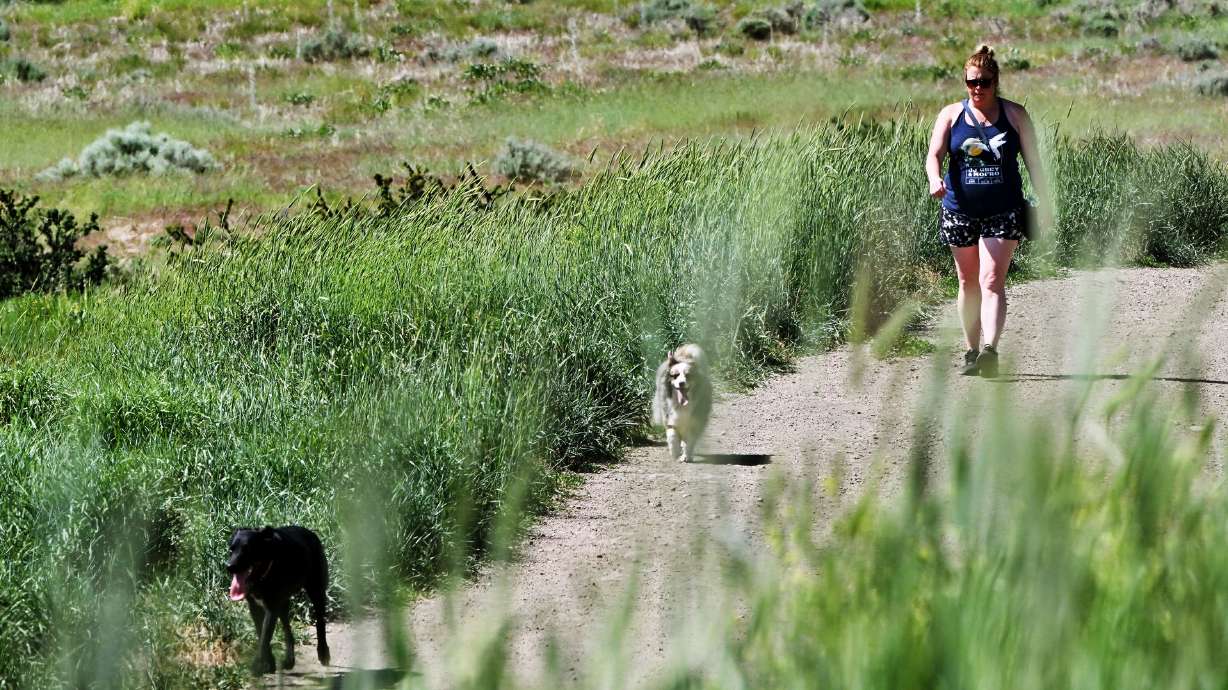Estimated read time: 5-6 minutes
- Foxtails pose significant risks to dogs, especially during summer hikes in the West.
- Veterinarian Sarah Nold warns foxtail seedheads can cause infections, abscesses and pyothorax.
- Prevention includes grooming, using protective gear and checking pets for foxtails post-hike.
SALT LAKE CITY — Summer is hiking season in the West, and bringing pets along for the walk just adds energy to any outdoor adventure.
But it also is important to beware of conditions along the trail or path you take.
Foxtail may seem like a harmless grass most of the time, but its seedhead can be devastating for dogs and other pets, as the barbs from the plants can get caught on the animal, burrow into the skin and cause a number of issues.
"They'll be walking through this tall grass or sniffing in it, and it gets stuck in their coat, and then it can start to work its way into the skin or into the ears or into the eyes, and can cause a whole host of problems after that," said Sarah Nold, a staff veterinarian with Trupanion, a pet insurance company.
According to Trupanion, cases of foxtail in pets across the country spike by 289% in the summer. Since 2020, the company has received over 5,800 foxtail-related claims.
Out of all foxtail-related claims in Utah, 75% happen during the summer months of June, July and August.
"We're kind of referring to those grass seeds that you see typically, especially when it gets more dry out and the grass starts to turn brown," said Nold. "I've heard people say it's spiky or barbed; some people say it's kind of shaped like an arrow or maybe torpedo-like, but that's what we're referring to."

What problems does foxtails cause?
Nold said that foxtails can cause a variety of issues. One issue is when it gets into a pet's eyes.
"They'll come in with their eye kind of held shut, or they're squinting, or their eye may look red. So it kind of gets, can get stuck behind the eyelid there. It can cause a scratch on the eye," she said.
When the foxtails get caught in a dog's hair or fur, it can burrow into the skin, bringing bacteria that will cause infections. This can also form abscesses. Nold said foxtails often get stuck in a dog's paws, particularly between the digits.

These foxtails will just keep migrating inside the body — they can migrate from the legs all the way to the back or chest.
According to Nold, foxtails can also cause pyothorax, which is an infection in the chest. Another way they can enter the body is by being inhaled through the nose; it can then migrate down into the lungs, which can cause issues.
It can also be very irritating for the dogs when it is in the skin, nose or eyes.
"If it goes in the nose, you're going to see a dog sneezing a lot, like very persistent sneezing, potentially nasal discharge and potentially just rubbing at that nose, trying rub it on the ground or rubbing it with its paws," Nold said. "It's not just an irritant, it can also lead to infection."
How to prevent foxtail problems
Nold said the best way to prevent these issues in pets is to keep them away from the plant. This can be done by people grooming or mowing any foxtail grasses in their yards or being careful of where they take their pets.
For dogs that are often out hiking or hunting, it can be hard to avoid foxtails completely.
Nold recommends trimming the hair around a dog's feet; there is also gear, such as booties or hoodies, to prevent the foxtails from getting caught in the paws or fur.
"The best thing would be to check your dog over carefully after frequenting those areas. So, watching for signs that they could have picked up a foxtail, such as if they're shaking their head or scratching at their ear or their eye or their nose, or potentially looking at a spot incessantly, such as between the toes, maybe a wound that doesn't heal, or they're holding their eyes shut, those sort of things," Nold said.
Nold emphasized that some of the best things pet owners can do for protection is to pick the foxtails out of their pet's coat and to groom them on a regular basis.

Are some dogs more at risk than others?
Research has shown that dogs with longer, thicker or curlier hair tend to be more susceptible to foxtail issues.
Nold said it's because "the foxtails can get trapped in their coat easier, and that's really the first step before it works its way into tunneling into the skin."
She added that any type of dog can be affected by the grass, but these types of dogs with dense, curly hair do have a higher risk.
Is this an issue for just dogs?
Foxtails are primarily an issue for dogs, but they can also affect cats — it's just less common.
"Because cats usually don't go running through tall grasses. They're usually not, you know, sniffing things on the ground, that sort of thing. But we definitely can occasionally see them in cats. Obviously, it'd be more of a cat that goes outdoors than an indoor-only cat," Nold said.
How to know your dog has foxtail issues
According to Trupanion, here are some signs of foxtail contact:
- Excessive scratching or pawing
- Head shaking or ear scratching
- Redness or swelling
- Discharge or bleeding
- Limping or favoring a limb
Signs of foxtail-related infection include, according to Trupanion:
- Redness and swelling
- Discharge or pus
- Fever
- Limping or reluctance to move
- Loss of appetite or vomiting
Taking your dog to the vet for foxtails
Nold said that when pet owners first begin to notice the signs of foxtail, the best thing to do is take the animal to the vet.
The earlier on that it is treated, the easier it is to remove the foxtail. Sometimes, the pet needs some sort of sedation or needs to be put under general anesthesia.
"But as I mentioned, as it migrates, it can cause more and more issues that can become very expensive, they can become very difficult to find as well. Sometimes you're just following the track of infection that leads to hopefully finding the foxtail and getting it out," Nold added.
She said that sometimes they don't find the foxtail, but they flush out the area as best they can to remove any foreign material, and often the animal is put on antibiotics and anti-inflammatory medication.











